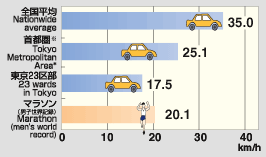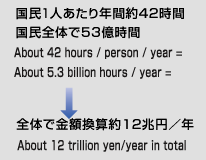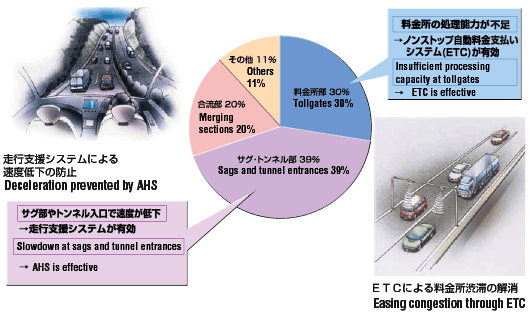Annual benefits due to alleviation of traffic congestion by ITS are estimated to be worth 1.2 trillion yen in 2015.
With a national deployment rate of 30%, VICS (Vehicle Information and Communication System, see 2-10, 11, 12, 13) would reduce the total loss due to traffic congestion by 6%.
ETC (Electronic Toll Collection System, see 2-1, 2, 3, 4, 5, 6, 7, 8, 9), AHS (Advanced Cruise-Assist Highway Systems, see 2-43, 44, 45, 46, 47, 48, 49, 50, 51, 52, 53, 54), and other ITS deployments could eliminate about 70% of traffic congestion on Japanese expressways.
Other effective methods are the real-time provision of the road traffic information, information on parking availability, and public transport system information; such information encourages the use of public transport through promotion of park and ride systems, and enables efficient road usage through TDM (Traffic Demand Management).
Traffic congestion in Japan today
Comparison of average travel speed during congestion (1999)

*The Tokyo Metropolitan Area consists of Tokyo and three Prefectures: Kanagawa, Saitama, and Chiba (source: Road Traffic Census 1999).
Loss due to traffic congestion (nationwide average)

Note: The figures were calculated using the data from the Road Traffic Census 1997.
|
Ratio of traffic congestion on expressways by road structure (1997)

Note: Sags refers to the location where a road structurally shifts from a down-grade to an up-grade. At this point, drivers are often unaware of the shift to the up-grade and they continue to step on the accelerator in the same way as on the down-grade, resulting in traffic congestion.
 Alleviation of traffic congestion resulting in annual benefits of 1.2 trillion yen
Alleviation of traffic congestion resulting in annual benefits of 1.2 trillion yen
 Alleviation of traffic congestion resulting in annual benefits of 1.2 trillion yen
Alleviation of traffic congestion resulting in annual benefits of 1.2 trillion yen


